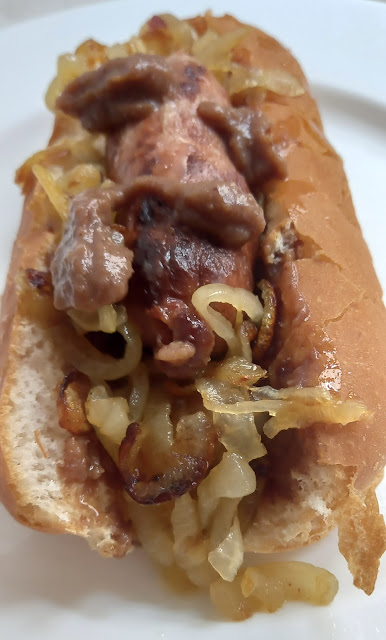Is ketchup just a posh way of saying brown sauce?
I watched the Great British Menu with great interest recently. This year, the theme was to celebrate Paddington Bear's 65th birthday. The chefs took their inspiration from the best of British animation and illustration when creating their dishes, and presented dishes inspired by references from cartoons to video games.
I was particularly enamoured by the food that was delivered on the Central England region heats.
Even more was I gobsmacked by the amount of mileage mushrooms were getting. Mushrooms this and mushroom that...earthy, meaty morels with their distinctive wrinkled caps to delicate golden chanterelles and skinny, silken enoki......dried shitaki and porcini featured in broths,duxelles, and were sautéed and stuffed. One particular Michelin starred chef Tom Shepherd endeared me to his food.
Proud Brummie Tom may be a newcomer to the Great British Menu kitchen, but he’s no stranger to winning, having received an Acorn award in 2018 - which celebrates the top 30 under 30 within the hospitality industry. Tom describes his food style as a seasonal, modern interpretation of classic combinations, where the emphasis is on creating big flavour.In 2021, he was able to open his own restaurant, "Upstairs", literally above his father´s shop, and received his own Michelin star just a few months later.
Under normal circumstances there can be only one Tom – head judge, Mr Kerridge, but in these particular heats he was joined by two more, Tom Shepherd and Thom (with an aitch) Bateman. Presenter Andi Oliver took to calling them Brummie Tom and North Staffs Thom. I’d have settled for Tom K, Tom S and Thom. Obviously, Tom K had to do more eating (along with his judge pals Nisha Katona and Ed Gamble). Tom S and Thom bonded too inevitably and cooked off until there was but just one Thom… or Tom left.
Thom’s starter, ‘Dragonology’, was a carved celeriac dragon’s leg flavoured with soy, white miso, mirin and rice vinegar, filled with caramelised celeriac puree and covered with crispy potato scales. It nested on a plate of sherry vinegar caramel, Sichuan pepper-pickled pink onions and a ketchup of dates, black garlic and roasted apple. Thinking that date ketchup was a first for them, the judges were enlightened by Tom K, who said "it’s just a posh way of saying brown sauce".
Ed Gamble was more than happy, as he’d been craving a slice of ‘Desperate Dan’s Cow Pie’ since this year’s brief was announced. Tom S obliged with his big beef cheek, potato and onion pie with a hot water and beef fat crust, served with roast sirloin steak, maple glazed carrots,and wait for it another ketchup, this time surprise surprise mushroom, chive emulsion and glossy gravy.
So is ketchup a cheffy way of saying brown sauce and when did mushrooms become ketchup? I investigated.
When the term ketchup first entered the English language, at the end of the. seventeenth century, it stood for something very different from the boiled tomato sauce we know today. At that time tomatoes were an expensive rarity, and ketchups were long-keeping,often vinegar based sauces flavoured with mushrooms, anchovies,onions,lemons,oysters and even pickled walnuts.They formed the essential ingredient of the proprietary sauces so popular with the Victorians,of which Worcester sauce is virtually the only survival.It was not until the early twentieth century, with the importation of cheap tinned tomatoes from America,that tomato ketchup began to encamp itself firmly in the centre of British meal tables.
The word ketchup itself comes, probably via Malay, from Chinese koechiap,literally ´fish juice`; this was a sort of relish made from pickled fish, probably similar to asian shrimp paste.The original spelling was catchup , and as early as the 1730´s this produced a spin-off version catsup, probably from some sort of erroneous or humorous association with´cats`and `supping´
A particular favourite of mine,of which I now make my own is Ketjap Manis.It's believed that ketjap manis was invented sometime in the mid-19th century. When Chinese migrants settled on Java, Indonesia's most populous island, they realized the local Javanese had a sweet tooth. So the Chinese added gula merah, or palm sugar (called gula jawa in Java), to soy sauce, and ketjap manis was born.
The spelling of Ketchup began to appear around 1710.
Here is my interpretation of Thom Bateman´s date ketchup.
8-10 dates,stones removed, softened in warm water (20mins) chopped
2 tbsp cider vinegar
1/2 small red onion, chopped
3 ripe baby pears ( 200g ) peeled and cored
2 tsp grated ginger
2 cloves garlic crushed
1 tsp onion powder
1 tsp garlic powder
2 tbsp Worcester sauce
2 tbsp pomegranate molasses
1/2 cup mushroom stock
mace, nutmeg, salt and pepper,to taste
Heat oil over medium heat in a small saucepan, then add the onions, stirring occasionally, until they have softened.Add the dates, pears, ginger and garlic,Worcester sauce,mushroom stock and pomegranate molasses and bring to a boil. Stir occasionally, and add water as needed to prevent burning. Cook for around 20-25 minutes, or until the sauce is thick and slightly darkened.
Remove the pan from heat and stir in the vinegar. Let the mixture cool down a little bit, and then stir in the vinegar. Blend everything together, adding water as needed, and spices, salt and pepper to taste.Bottle in sterilised jar or squeezy bottle.




Comments
Post a Comment